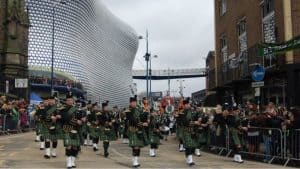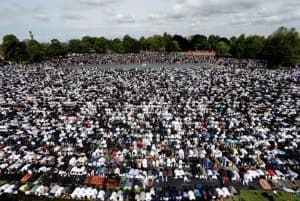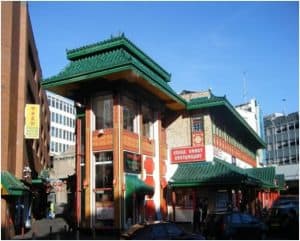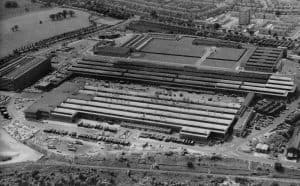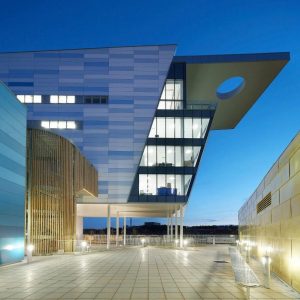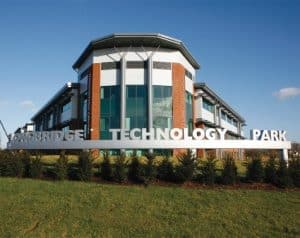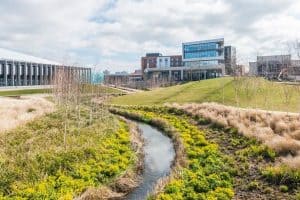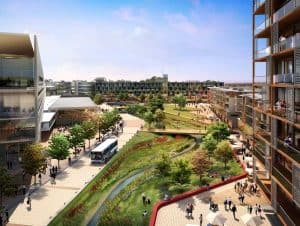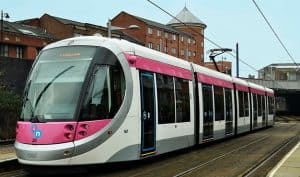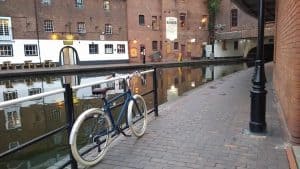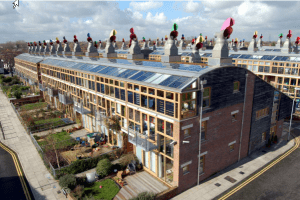UK cities and there distribution
The UK is densely populated in the south and east. There is flatter land here, warmer temperatures and less rain. As a result there is land for farming, industry and homes. There may be resources to mine and good transport links too.
The UK is sparsely populated in the north and west. Here the relief of the land is steep, temperatures low and rainfall high. As a result there is less land suitable for farming or industry or homes. There may be a lack of resources or transport too.
This table shows the UK’s 10 biggest cities with their population size from the 2011 Census.
| 1 | London | 8,173,941 |
| 2 | Birmingham | 1,085,810 |
| 3 | Glasgow | 590,507 |
| 4 | Liverpool | 552,267 |
| 5 | Bristol | 535,907 |
| 6 | Sheffield | 518,090 |
| 7 | Manchester | 510,746 |
| 8 | Leeds | 474,632 |
| 9 | Edinburgh | 459,366 |
| 10 | Leicester | 443,760 |
CASE STUDY
Growth of Birmingham
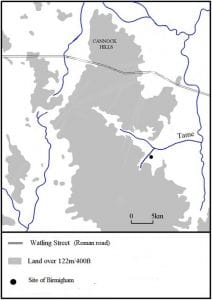 Birmingham is located in the centre of the UK. It started as a small village on the bank of the River Rea. It is situated just to the east of the Birmingham Plateau – a flat topped area of high land. Most of the plataeu was covered by the Forest of Arden when the settlement of Birmingham began.
Birmingham is located in the centre of the UK. It started as a small village on the bank of the River Rea. It is situated just to the east of the Birmingham Plateau – a flat topped area of high land. Most of the plataeu was covered by the Forest of Arden when the settlement of Birmingham began.
This graph shows the increase in Birmingham’s population.
In 1087, at the time of the Doomsday Book, Birmingham had a population of 9 people. By the 16th century Tudor Period the population had grown to 1000 people.
The population started to increase after 1769 when the canals arrived. It grew rapidly after the railways came in 1837. Birmingham officially became a city in 1889.
Birmingham’s population peaked at nearly 1.2 million around 1950, following its important role in manufacturing vehicles and weapons in WW2.
In the 1960s and 70s the population fell as many traditional industries closed down. Recently many inner city areas have been regenerated and the population has begun to rise again.
Importance of Birmingham
In the 19th century the city was known as the ‘workshop of the world’. The important industry was metal working – making steam engines, gun barrels, pen nibs, buttons and coins.
Today Birmingham is the UK’s second largest city with 1.1 million residents – compared to London with 8.2 million. It accounts for 4% of the UK’s GDP (Gross Domestic Product). This is the value of all the goods and services produced. Birmingham is second only to London which accounts for 28% of the UK’s GDP.
Today the main employers are Cadburys, Rolls Royce and Jaguar. Manufacturing is still an important industry in Birmingham. However, services in the city, such as retailing, now employ more people.
Migration to Birmingham
The city has experienced migration from Ireland in the 1850s after the potato famine and with Jews escaping persecution in Europe in the 1930s. Today Birmingham’s large Irish community holds a St Patricks Day parade every year.
After WW2 people migrated to Birmingham from India, Pakistan, Bangladesh, China, Jamaica in search of jobs and more recently refugees from wars in Somalia and Afghanistan have arrived. Birmingham has the largest gathering of Muslims in Europe for the festival of Eid.
Some neighbourhoods in Birmingham, such as Ladywood and Hodge Hill are very multicultural. For example Ladywood is 32% white, 39% Asian and 20% black. There is also an Irish Quarter and Chinatown in Birmingham.
Opportunities in Birmingham
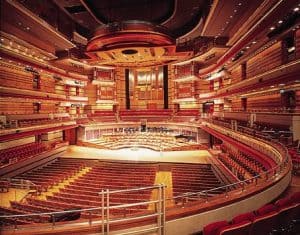 Birmingham’s residents can enjoy music at the NEC, Barclaycard Arena or Symphony Hall.
Birmingham’s residents can enjoy music at the NEC, Barclaycard Arena or Symphony Hall.
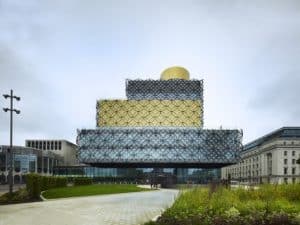 They can experience culture at the new £189 million library.
They can experience culture at the new £189 million library.
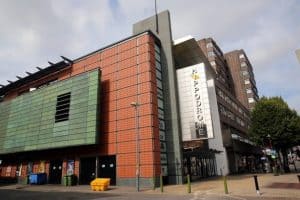 They can visit the Hippodrome theatre – the UK’s most visited.
They can visit the Hippodrome theatre – the UK’s most visited.
 Birmingham has 5 universities and 60 000 students.
Birmingham has 5 universities and 60 000 students.
 Recreation opportunities include 500 parks or watching sports teams such as Aston Villa
Recreation opportunities include 500 parks or watching sports teams such as Aston Villa
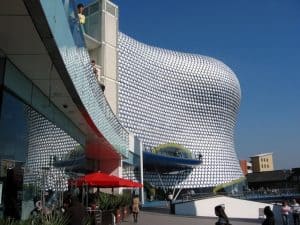 The city has many new shopping areas such as the Bull Ring.
The city has many new shopping areas such as the Bull Ring.
Challenges in Birmingham
1) Urban deprivation
Deindustrialisation has created challenges for the city. Many old industries have closed and moved away from the inner city.
This has left many inner city areas, such as Ladywood, with high levels of deprivation. Here 13% are unemployed, 47% of children live in poverty, 54% of pupils get 5 GCSEs and the life expectancy is 76.
By contrast in Sutton Coldfield is on the rural urban fringe. There, unemployment is only 1%, only 12% of children live in poverty, 83% of pupils get 5 GCSEs and the life expectancy is 83.
2) Derelict brownfield sites
Deindustrialisation leaves many brownfield sites in the inner city – a site which has been built on before.
These can be redeveloped – knocked down and rebuilt – or renewed – repaired and converted. Examples of redevelopment include Selfridges and the new library. Examples of renewal include the Mailbox and Gas Street Basin.
| Advantages of brownfield sites | Disadvantages of brownfield sites |
|
|
3) Greenfield sites
The alternative to building on a brownfield site is to use a greenfield site – a site that has not been built on before.
On the rural urban fringe of Birmingham new homes are planned on greenbelt sites. The greenbelt is a ring aroind majo UK with planning restrictions to prevent development. This is designed to reduce urban sprawl – the outwards spread of a city.
| Advantages of greenfield sites | Disadvantages of greenfield sites |
|
|
4) Greenbelt and urban sprawl
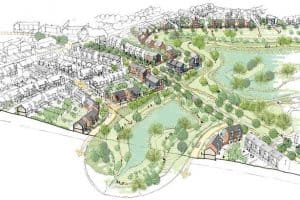 Greenfield sites on the rural urban fringe are under pressure in Birmingham. In Sutton Coldfield, there are plans to build 6000 new homes on 175 acres of farmland (known as the greenbelt). This is because Birmingham needs 89 000 new homes but only has space for 51 000 on brownfield sites. New homes built on the greenbelt provide excellent family homes with good transport links as they are close to the motorway. Newly built homes can also be energy efficient.
Greenfield sites on the rural urban fringe are under pressure in Birmingham. In Sutton Coldfield, there are plans to build 6000 new homes on 175 acres of farmland (known as the greenbelt). This is because Birmingham needs 89 000 new homes but only has space for 51 000 on brownfield sites. New homes built on the greenbelt provide excellent family homes with good transport links as they are close to the motorway. Newly built homes can also be energy efficient.
However, 11 000 local people signed a petition against this 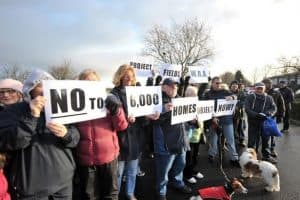 development. They claim that there are 5000 empty homes in Birmingham to use first. Building on greenfield sites will mean the loss of countryside and views, as well as habitats in oak trees and hedgerows. This spread of a city is called urban sprawl. New homes will increase pressure on local services such as hospitals. Also 80% of the new residents will drive leading to more congestion and pollution because these homes are commuter settlements.
development. They claim that there are 5000 empty homes in Birmingham to use first. Building on greenfield sites will mean the loss of countryside and views, as well as habitats in oak trees and hedgerows. This spread of a city is called urban sprawl. New homes will increase pressure on local services such as hospitals. Also 80% of the new residents will drive leading to more congestion and pollution because these homes are commuter settlements.
5) Waste disposal
A typical Birmingham household throws away 682kg of rubbish a year. Of that, food waste accounts for 34%, plastics 18% and paper & card 8%. Currently 70% of the city’s rubbish is incinerated and electricity is generated for 40 000 homes. The city council is hoping to reduce this and the amount that goes to landfill -7%- by improving the recycling and reuse of materials. The council says 50% should be recycled by 2020.
UK example of urban regeneration
MG Rover closed in 2005 and 6000 people lost their jobs. This had knock on effects on employment in many companies that supplied components to the car factory. Unemployment created problems in the community, such as crime and deprivation. The derelict factory left site needing urban regeneration in Longbridge, Birmingham.
A new college (£66 million Bourneville College) has been built, along with a shopping centre, a youth centre (The Factory) and the Longbridge Technology Park for new media businesses and a Business Park for industry such as a data centre.
Urban greening improved this area with a new park (Austin Park) created along the banks of the River Rea. Also, green corridors have been created between buildings for open space.
Urban transport strategies
Traffic congestion is a problem in Birmingham. Spaghetti Junction is 4th worst traffic hotspot in the UK and a typical traffic jam lasts 3 hours, stretches 5 miles and contains 3000 cars. It wastes £2 billion of time per year. Congestion leads to air pollution. Birmingham is in the top three most polluted UK cities along with Leeds and London. This contributes to 520 deaths per year.
The new 13 mile long Midland Metro tram system transports 4.8 million people per year. Congestion is also reduced with new cycle routes along 50km of resurfaced canal towpaths.
Sustainable urban living
A sustainable house is one that provides people with a home today but does not use up all the resources for the next generation.These homes have thick insulation to reduce wasted heat. They have south facing windows to capture natural light and heat from the sun. The wind cowls on the roof are connected to heat exchangers to reduce heat lost when windows are opened for ventilation. They use energy saving light bulbs and appliances to reduce electricity use. Solar palnels on the roofs provide renewable power and recharge electric cars. Rainwater is collected from roofs for flushing toilets and use in the gardens.


